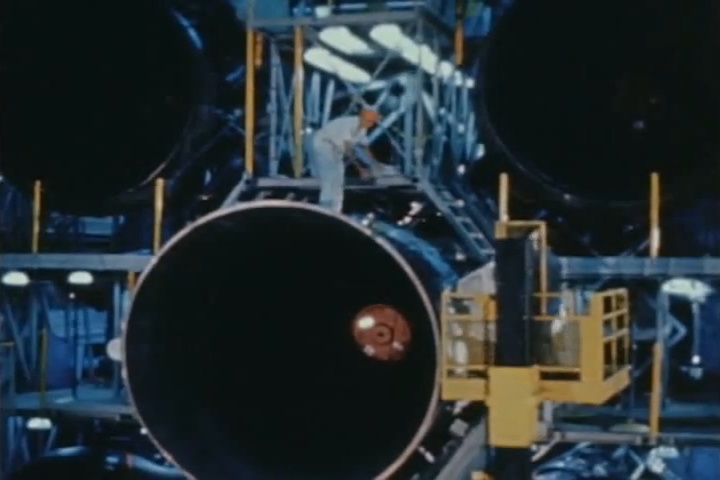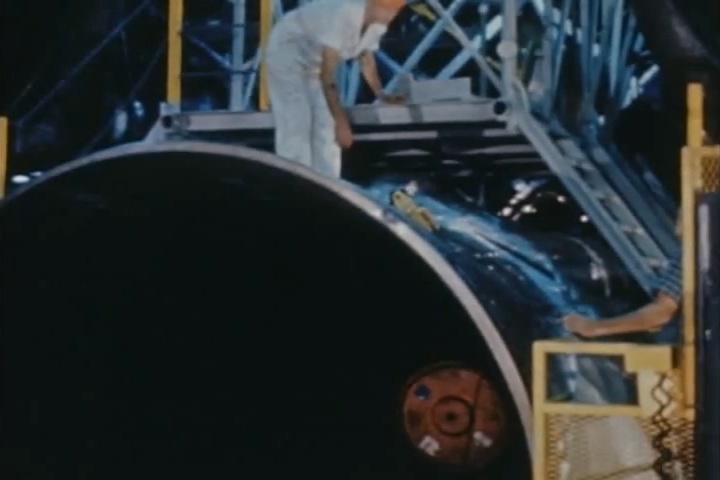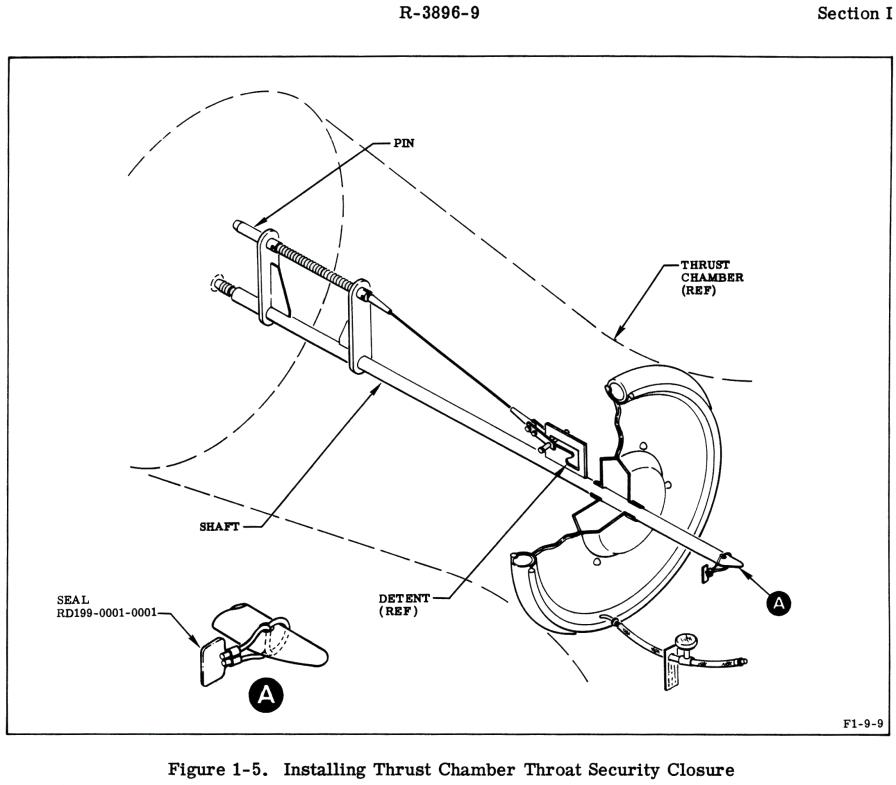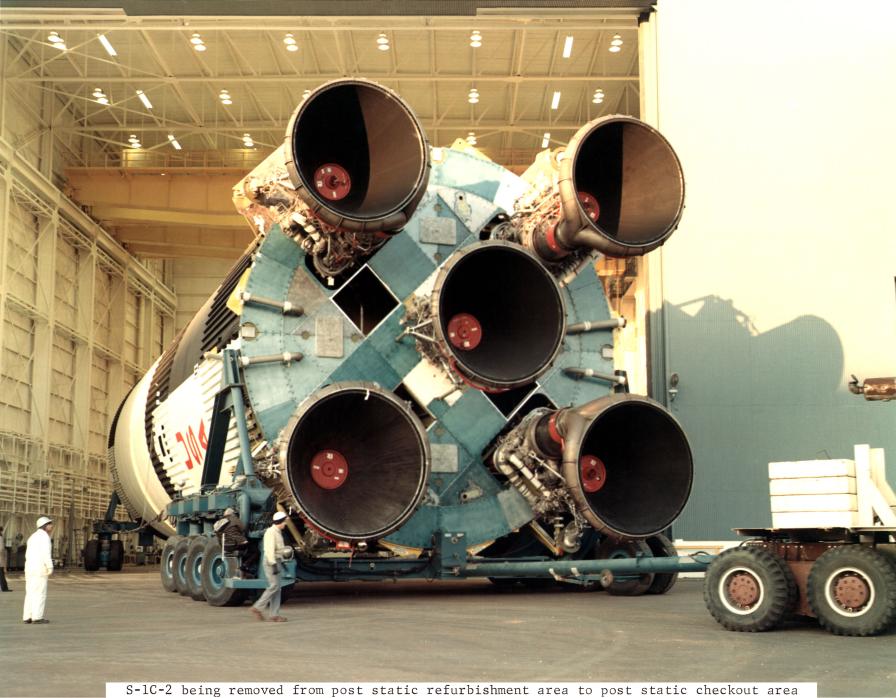F-1 Engine Thrust Chamber Throat Security Closure
F-1 engines had a "Thrust Chamber Throat Security Closure G4089" installed during shipping. A shaft on which to mount the closure was installed in a threaded hole in the center of the F-1's injector; desiccant was placed between the injector and the security closure to protect the engine during shipping or storage.
The thrust chamber throat security closure shaft is in the lower right of the image (part #33A).
Click image for a 1066x1386 pixel version of this image in a new window.
Taken from p. 2-181 of the F-1 Rocket Engine Technical Manual:
Illustrated Parts Breakdown. While the particular PDF from which I
extracted this image seems to no longer be available on the Internet, a lower-quality
scan is available elsewhere.
Extraction by heroicrelics.org.
A scan from the F-1 Transportation Manual which shows the shaft:
Click image for a 2186x1916 pixel version of this image in a new window.
Picture courtesy Vince
Wheelock. Also available
electronically elsewhere.
On one of my visits to the USSRC, I chatted with a volunteer who worked at the Michoud Assembly Facility (MAF) during the program. He told me that, back in the day, the design of the F-1's injector was classified and that there was a cover with a combination lock to protect the injector from unauthorized viewing.
While initially researching this closure, I just accepted the "security" as part of the closure's name, without thinking about it too much. However, the legend for the thrust chamber closures diagram above also lists part #33, RX20700-11 "Closure Assy. Thrust chamber throat (For inter- and intra-plant use only)" in addition to the thrust chamber throat security closure, and the diagram itself implies that either closure can be used. Presumably, the "security" version of this closure was used if there was the possibility that the engine would be subjected to unauthorized personnel and the "ordinary" version of the closure would be used in other cases.
The diagram above shows only the "Seal RD199-0001-0001", rather than a combination lock. However, some time later I read procedures on page 1-107 of the F-1 Rocket Engine Operating Instructions regarding the thrust chamber throat security closure which refer to a "combination padlock 9026900", so it certainly seems that a combination lock was used at some point:
Paragraph Activities Requirements Limits Special Constraints and Remarks 1.6.18 THRUST CHAMBER THROAT SECURITY CLOSURE INSTALLATION a. Remove thrust chamber exit closure, if installed. Thrust chamber throat closure RX20700 is an acceptable alternate for thrust chamber throat closure G4089. b. Clean threaded hole in center of injector. c. Retract and secure pin in detent on security closure shaft. d. Install shaft in threaded hole in center of injector until shaft bottoms aline pin between extensions on injector face; then release pin from detent position e. Install desiccant in closure as specified in section II 48 units. Closure humidity indicator must be blue within 24 hours after installation of desiccant. NOTE
Desiccant must not be removed from its air-tight container until just prior to installation.f. Install closure on shaft. Aline hole in closure extension with hole in shaft, and install combination padlock 9026900 through closure and shaft. g. Inflate closure tube with gaseous nitrogen. 5-7 psig h. Reinstall thrust chamber exit closure, if required. 1.6.19 THRUST CHAMBER THROAT SECURITY CLOSURE REMOVAL a. Remove thrust chamber exit closure, if applicable. Thrust chamber throat closure RX20700 is an acceptable alternate for thrust chamber throat closure G4089. b. Deflate security closure tube. c. Remove padlock, and remove closure from shaft. d. Place shaft pin in detent position and unscrew shaft from injector. e. Remove desiccant from security closure and store as specified in section II. f. Package security closure for storage by enclosing in a clean plastic bag and cushioning in a box with polyurethane material. g. Reinstall thrust chamber exit closure, if applicable.
Here's a picture of an S-IC whose F-1s have the throat closures installed. It's hard to tell here, but I can't see the shaft sticking out of the center of the closures in the S-IC rollout picture below, so this stage may well have the RX20700-11 covers installed, rather than the thrust chamber throat security closure.
Click image for a 2827x2203 pixel version of this image in a new window.
Picture courtesy Vince
Wheelock.
The original version of this photo came with two captions, one which appeared to be typed up and affixed to the photo, plus one which appeared to have been added electronically under the scan, with the other caption referring to S-IC-1 and January 27, 1966.
Alan Lawrie notes that since S-IC-1 was placed in the static test stand on January 24, 1966 and wasn't static-fired until February 17, 1966, it couldn't be in a building and wouldn't have undergone post static refurbishment by January 27, 1966. He also notes that some time between January 17, 1966 and February 1, 1966 S-IC-2 was transferred from the Manufacturing Engineering Laboratory (which is Building 4755, also referred to as the "Multi-Purpose Vehicle Assembly Building") to the Quality and Reliability Assurance Laboratory (which seems to be Building 4708) for post-manufacturing checkout. (Building number information gleaned from History of the George C. Marshall Space Flight Center, 1 Jan. - 31 Dec. 1965, Volume 1.)
Only S-IC-1's engines had straight (internally-tied) fuel high-pressure ducts; starting with S-IC-2 the F-1s had "U"-shaped (rigid) fuel high-pressure ducts. Although not the best angle to make this determination, it appears that the ducts are "U"-shaped.
Given all this, one possible explanation is that this is S-IC-2 on January 27, 1966, being moved from Building 4755 to Building 4708 for post-manufacturing checkout. And, just to throw a monkey in the wrench, Alan notes that some time between December 1965 and April 1966 S-IC-2's engines were removed for cleaning. But, there's only so much one can obsess about over a caption :-)
The throat closures are visible in these video captures from an untitled YouTube video:


Technicians working on F-1 rocket engines.
Taken from an untitled NASA film which, unfortunately, seems to no longer be available from
YouTube, and since it had no title, I am uncertain where to find an
alternate source.
Extraction by heroicrelics.org.



